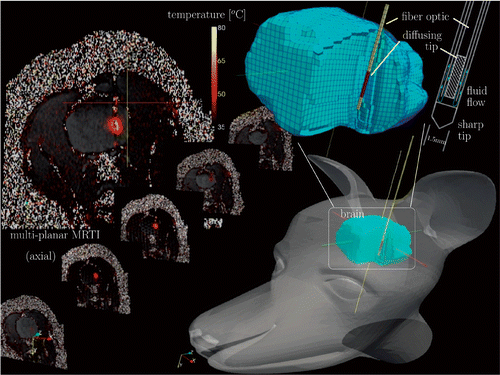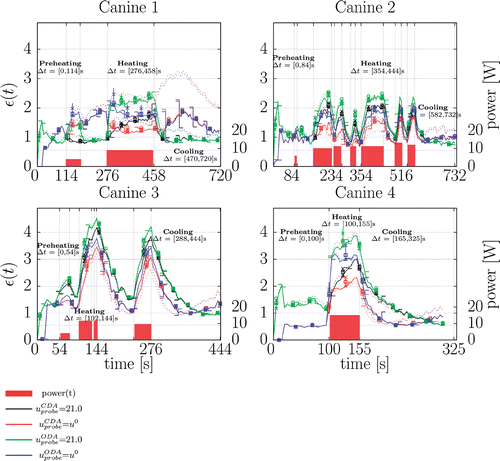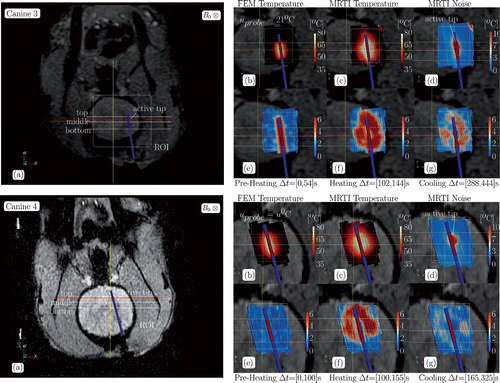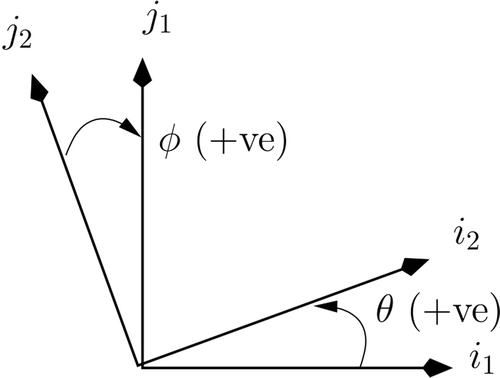Figures & data
Figure 1. Schematic diagram of in vivo MR-guided LITT procedure in a canine model of brain. A 1.5-mm diameter water-cooled diffusing tip applicator was introduced percutaneously through the parietal bone. The applicator consisted of two clear, concentric tubes for water flow, the central of which contains an active 1-cm diffusing tip 400 µm diameter silica fibre-optic. Delivery of the photothermal energy is monitored using a multiplanar EPI sequence for MR temperature imaging.

Figure 2. Normalised error history. The history of the L2 error normalised by the measured multiplanar temperature image noise (4), ϵ(t), is shown for each canine in this study. The normalised error is dimensionless. Data is plotted at . The error bars shown provide the error range for the perfusion values considered; error bars left and right of the vertical axis plot
, respectively. Dotted lines plot ω = 0.0 for comparison. Permutations of laser (CDA, ODA) and cooling model uprobe = (21°C,
) are shown for each canine. The power history of the thermal dose deliver is plotted against the right axis as a reference. Power is provided in W. The labelled time intervals highlight three regimes of interest: prior to heating, during heating, and during cooling. The corresponding pointwise maximum error plots during each of the regimes is provided for the centre plane of the multiplanar data in . The -×-□-○-Δ sequence shown illustrates the convergence of the finite element numerical solution throughout the thermal dose history. The -×-□-○-Δ plots values of the error metric (4) at
when monotonically increasing the mesh resolution (decreasing element diameter from 2 mm to 0.5 mm).

Table 1. Constitutive data Citation[9], Citation[23], Citation[24]
Figure 3. Canine 1-2 data summary, CDA, (a) The anatomical position of the ROI and the spatial profiles used in are illustrated on magnitude images of the anatomy. Cutplanes through the ROI of the finite element data used in is shown in (b–g). Cutplanes are coplanar with the applicator. The pointwise maximum over time for the (b) FEM predicted temperature, (c) MR temperature data, and (d) MR temperature noise is provided in °C. The pointwise maximum normalised error (5) over time for the (e) pre-heating, (f) heating, and (g) cooling regimes labelled in are provided.

Figure 4. Canine 3-4 data summary, CDA, (a) The anatomical position of the ROI and the spatial profiles used in are illustrated on magnitude images of the anatomy. Cutplanes through the ROI of the finite element data used in are shown in (b–g). Cutplanes are coplanar with the applicator. The pointwise maximum over time for the (b) FEM predicted temperature, (c) MR temperature data, and (d) MR temperature noise is provided in °C. The pointwise maximum normalised error (5) over time for the (e) pre-heating, (f) heating, and (g) cooling regimes labelled in are provided.

Figure 5. Canine 1-4 spatial profiles summary, CDA, The (a) top, (b) middle, and (c) bottom profiles illustrated in , 4(a) plot the maximum over time of the MR temperature data (°C), computational prediction (°C), and MR temperature noise (°C) against distance (mm). Profiles extend beyond the ROI used in normalisation in ; the boundary of the ROI is denoted on the profiles.

